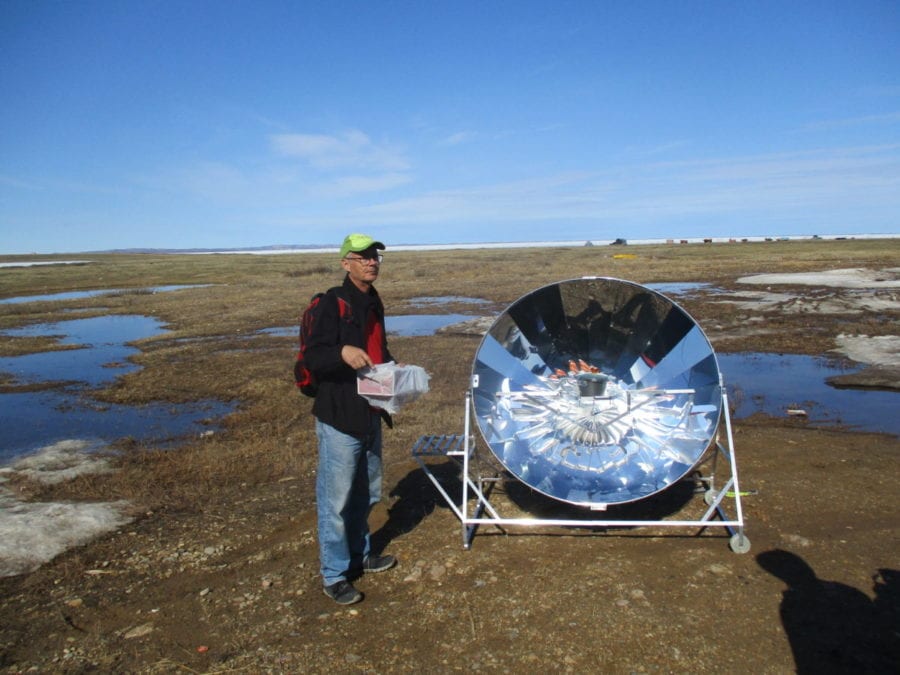Students in Tuktoyaktuk are gearing up to assemble a new solar cooker donated by a green entrepreneur with a long history in the north.
In the solar energy business for 13 years, Klaus Dohring started getting involved in projects in the Arctic about eight years ago. Since then, he's set up dozens of solar power systems and donated solar cookers to several communities, including in Paulatuk and now Mangilaluk School in Tuktoyaktuk.

Photo courtesy Green Sun Rising
"A solar cooker is a beautiful way to demonstrate the power of the sun", he said, adding collectively his systems are now producing enough energy to save up to 170,000 litres of diesel fuel each year. "To my best of knowledge, nobody has done as much diesel reduction via solar systems as we have."
Solar Cookers are large, bowl-shaped mirrors which concentrate sunlight to a single point in the centre of the bowl. A specially painted black pot is placed in path of the reflected sunlight, which can boil a litre of water in nine minutes under good conditions. However, a normal black pot can be substituted in if needed.
Dohring said the cookers were effective as early into the year as March, so long as the user can keep strong winds from cooling the unit down. An unassembled solar cooker with a specialized pot costs $880-plus shipping.
"You can boil water, you can boil stew, it allows you to cook fast and hot," he said. "You need to follow the sun every half-hour, give or take. You want to have an area that is not windy so that the wind doesn't carry heat energy away. Other than that, all you need is clear sky and full sunshine.
"I have worked in March, in Inuvik. The temperature was -30C. The sun came out. All the snow and ice on the front of the modules melted, and I had water dripping onto my neck. You have several phenomena in the Arctic which, on clear sunny days allows you higher irradiation. The first factor is that you have very clean, dust-free air. You do not have the pollution particles in the air. The second factor is even more important, you have very cold and therefore dry air. For that reason, you have less solar filtration.
"I have measured with my irradiation meter 1,140 watts-per-square-metre. We define 1,000 watts as full sunshine, so I'm telling you that I have measured 14 per cent higher irradiation in Paulatuk in a late afternoon than what is rated at prime conditions."
He said his company, Green Sun Rising, was planning to pay another visit to Tuktoyaktuk once the pandemic clears, but in the interim added he wanted to draw attention to another solar technology he felt the north could make good use of — solar heating.
Dohring said the technology would be highly effective in the north, suggesting it would be more efficient than using solar for strictly electricity production.
"Canadians are crazy about solar photovoltaic and that's good," he said. "But are we're absolutely ignoring the fact we actually spend more energy on heat generation than we spend on electricity. Heat energy is by far the bigger elephant in the room.
"Solar thermal has a much higher efficiency than solar voltaic. My solar thermal collectors have 80 per cent peak efficiency. They're also practically maintenance free. It's free heat energy coming in whenever the sun. So I would to promote solar thermal, in particular if you have a community where diesel is used for electricity generation and that electricity is used to heat water.
"That is thermodynamically evil. Domestic hot water consumption is fairly constant throughout the year and I can save you approximately half of your annual energy needs for domestic hot water with a solar thermal system."
Green Sun Rising has installed numerous solar systems in Inuvik, including lots collecting power for Stanton's, the Inuvik Liquor store and Children's First Centre, among close to 30 systems in several other Arctic communities across the north, including Tuktoyaktuk and Paulatuk.
A plan to come up to Tuktoyaktuk to install two more solar energy systems is in the works for the summer, depending on how the pandemic goes over 2021.